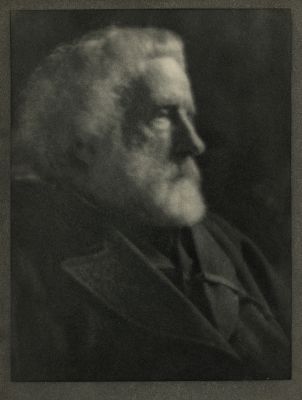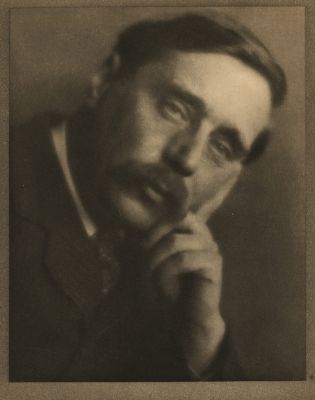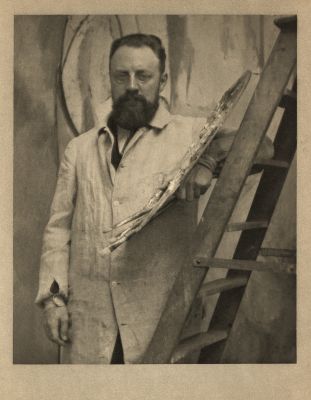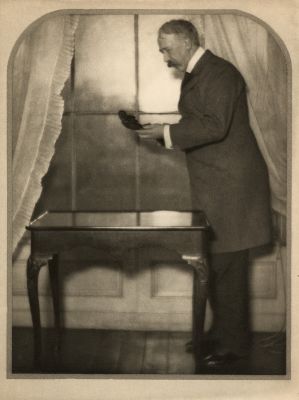
Title
John Masefield, HampsteadArtist
Coburn, Alvin Langdon (American, 1882-1966)Key FigurePublication
Men of MarkDate
1910Process
PhotogravureAtelier
Alvin Langdon CoburnImage Size
31 x 23.5 cm
Some of Coburn’s most impressive photographs are portraits. He worked for a year in the studio of the leading New York portrait photographer Gertrude Käsebier and became friendly with George Bernard Shaw, who introduced him to a number of the most celebrated literary, artistic and political figures in Britain, many of whom, including Shaw, he photographed. Shaw also wrote the preface to the catalogue for the exhibition of Coburn’s work at the Royal Photographic Society, London, in 1906, and regarded Coburn and Edward Steichen as ‘the two greatest photographers in the world’. Coburn produced two books of portraits: Men of Mark (1913) and More Men of Mark (1922).
The thirty-three photogravures comprising Men of Mark were printed at “Thameside,” Coburns photogravure atelier, in October 1913. The portraits for Men of Mark took nine years to assemble, and those for More Men of Mark, a companion volume in collotype published in 1922, another nine years. Influenced by Hill and Adamson, and using their original concave mirror to modify light, the photogravures are representative of the evolving aesthetic of one foot in the pictorialist tradition while the other undoubtedly modern. “The portraits he produced are astonishingly modern even today and are influenced by his ‘‘rediscovery” of the work of nineteenth-century photographers David Octavius Hill and Robert Adamson and more importantly, Julia Margaret Cameron. Like Cameron’s, Coburn’s early portraits show the sitters dislocated in time and space, with little extraneous detail, as sublimations of the subjects and their work.” [1]
Coburn was well read and, because if his admiration for many writers, he wished to meet and photograph them. Commencing with George Bernard Shaw, Coburn set out to portray many of the leading British authors of the early twentieth century. Among those that sat before his lens were G. K. Chesterton, Henry James, George Meredith, and William Butler Yeats. In 1913, Coburn selected 33 of his most insightful portraits for the book. As with his previous books, Coburn printed the exquisite photogravures on his own Thameside press, in an edition of 300 copies.
Coburn’s work as a portrait photographer was initially spurred in 1904 by Perriton Maxwell, editor of the Metropolitan Magazine, who – "Out of the kindness of his heart, or, perhaps, more to get rid of me than anything else"- gave Coburn a list of prominent people to photograph in Britain. The photographer first reached out to George Bernard Shaw (whose portrait opens the book), and through his friendship with Shaw met many other important figures. It became a long-term undertaking, undoubtedly both satisfying and exciting Coburn’s self-described "urge" to photograph those artists whom he admired: I have always been deeply interested in consummation in the arts, and I think this was the chief reason why I began making photographic portraits. If I admired the writings or expressed vision of any person, I was impelled by the desire to meet and photograph him…My portraits are a recording of my appreciation of the artistic achievement of the times in which I have lived. [2] . Coburn "was the most important American photographer of his generation to expend significant energy on illustrating books" and "expressed rare versatility in his facility at landscape and city views, while at the same time making penetrating portraits." [3]
Reproduced / Exhibited
Coburn, Alvin L, Karl Steinorth, Nancy Newhall, and Anthony Bannon. Alvin Langdon Coburn – Photographs, 1900-1924. Zürich: Stemmle, 1998. Plate 144.
References
[1] Roberts, Pamela Glasson Coburn Alvin Langdon Pamela Glasson Roberts Fundación Mapfre and George Eastman House. 2014. Alvin Langdon Coburn. Madrid: Fundación Mapfre. p. 23
[2] Coburn, Alvin Langdon, Alvin Langdon Coburn : Photographer : An Autobiography, pp. 24-42.
[3] The Truthful Lens; Foster, Sheila J., et al. p. 37
Foster, Sheila J, Manfred Heiting, and Rachel Stuhlman. Imagining Paradise: The Richard and Ronay Menschel Library at George Eastman House, Rochester. Göttingen: Steidl, 2007 p. 236











